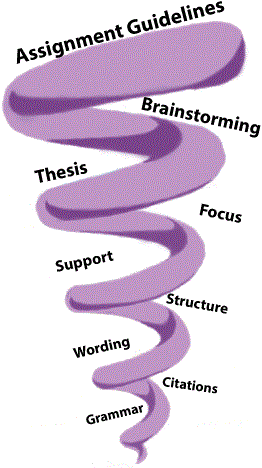The Spiral Approach
 The Writing Spiral prioritizes important aspects of the writing process. We use this visual tool in our sessions in order to focus on the parts of the process and paper that need the most attention.
The Writing Spiral prioritizes important aspects of the writing process. We use this visual tool in our sessions in order to focus on the parts of the process and paper that need the most attention.
Assignment Guidelines
Assignment guidelines are at the top of the spiral because they are the first consideration. If you don’t respond to the prompt, then the whole focus of the essay isn’t on point.
Brainstorming
Throughout the writing process, but especially in the beginning, idea development and related details have to come from somewhere. Taking the time to explore what you already know and where you might find additional ideas and details to consider is crucial. This is a time to open your mind to all the possibilities!
Thesis
Whether you begin with a working thesis to establish your purpose or use the first draft to discover your thesis, in academic essays strong, complex theses are essential. The thesis statement focuses your topic and presents your purpose and the overall point that you will make and support in your essay.
Focus/Unity
Focus and unity in any type of paper allows the reader to stay with you from sentence to sentence and paragraph to paragraph. Without focus and unity, the reader may not see the purpose and direction of a paper.
Supporting Points and Evidence
Having strong supporting ideas builds your discussion, and having evidence backs up those ideas. Often academic writing requires multiple sources and types of evidence such as personal examples, articles, books, and online resources. Types of evidence vary depending on the purpose, context, and audience of the paper.
Structure/Organization
Organization allows your paper to flow from point to point. It helps present your arguments clearly and in an order that is persuasive and comprehensible to the reader.
Citation/Documentation
Citing all quotes, summaries, and paraphrases from your sources is crucial. It gives credit where it’s due and provides a pathway for your reader’s further research. It’s important to learn how to formulate your citations correctly.
Grammar/Editing
Grammar is the last item on the spiral, not because it’s not important, but because it becomes important only after higher level concerns are addressed. Once the purpose, focus, support, organization, and documentation are clear, editing for grammar and surface errors becomes more relevant and important.

